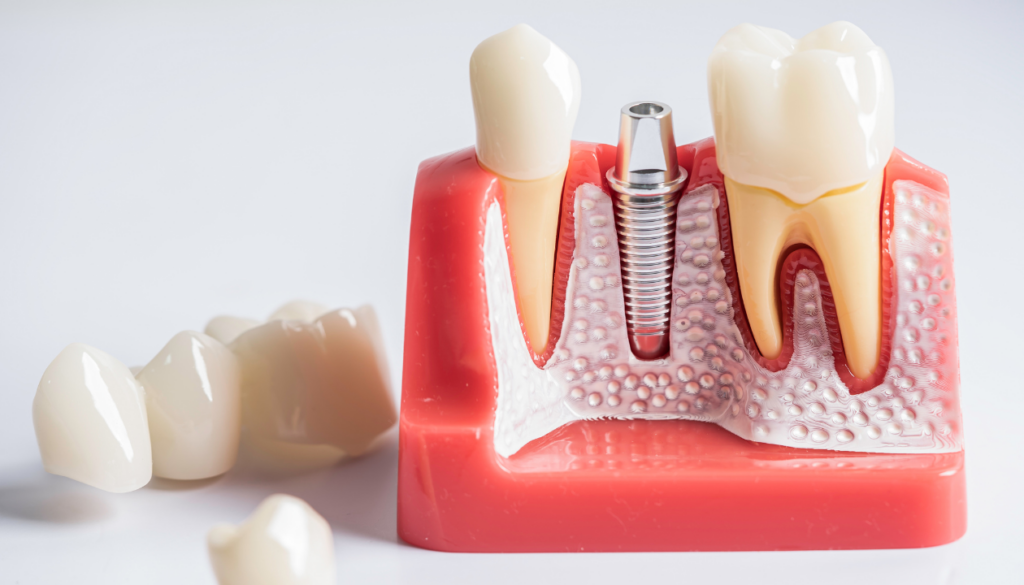Dental implants have revolutionized the way we approach tooth replacement, offering a solution that mimics the look and function of natural teeth. With over 3 million people in the U.S. opting for this treatment, and that number growing by 500,000 each year, it’s clear that many are choosing implants over traditional dentures and bridges.
If you’re considering dental implants, understanding the process can help ease any concerns you might have.
This step-by-step guide will walk you through the entire journey, from the initial consultation to the final placement of your new teeth. You’ll learn about the meticulous planning involved and the surgical procedure that ensures a successful outcome.
By demystifying the dental implant process, you’ll gain confidence in your decision to restore your smile and enhance your oral health.
Overview of Dental Implants
Dental implants serve as a revolutionary method for replacing missing teeth, enhancing both function and aesthetics in your smile. Understanding their structure and advantages is vital for making an informed decision about your dental health.
What Are Dental Implants?
Dental implants consist of artificial tooth roots, typically crafted from titanium, which are surgically inserted into your jawbone. This procedure provides a stable foundation for permanent or removable replacement teeth like crowns and dentures.
The implant fuses with the jawbone during a process called osseointegration, ensuring both strength and durability. This secure attachment means your new teeth look, feel, and function similarly to natural teeth.
Benefits of Dental Implants
Dental implants offer numerous advantages compared to traditional tooth replacement options such as dentures or bridges:
- Fixed Support: Unlike dentures, implants remain securely in place, allowing you to eat, speak, and smile confidently without concern for slippage.
- Bone Preservation: Implants stimulate the jawbone, preventing bone loss that often occurs when a tooth is missing. Sustaining jawbone health is critical for overall oral function.
- Adjacent Teeth Conservation: Implants don’t require alteration of nearby healthy teeth, preserving their integrity as opposed to bridges that often necessitate modifying adjacent teeth.
- Enhanced Comfort and Self-esteem: Your ability to eat and speak comfortably improves significantly with implants, positively impacting your confidence and quality of life.
- Long-term Solution: With proper care, dental implants can be a long-lasting solution, often exceeding the lifespan of traditional restorative options.
These benefits emphasize why dental implants represent a preferred choice for many individuals seeking to restore their smiles and enhance their functional capabilities.
How Do Dental Implants Work?
Dental implants function as artificial tooth roots, providing a reliable foundation for replacement teeth. The process involves several critical steps that ensure the successful integration of the implant into your jawbone.
Step 1: Initial Consultation and Assessment
During the initial consultation, your dentist evaluates your oral health to determine your candidacy for dental implants. You’ll discuss your medical history, concerns, and goals.
The dentist conducts a thorough examination, which may include X-rays or 3D imaging, to assess bone density and gum health. This assessment ensures that any potential issues are addressed before proceeding with treatment.
Step 2: Treatment Planning
After the consultation, careful treatment planning occurs. Your dentist creates a customized plan tailored to your specific needs. This may involve designing a surgical guide that outlines the precise angle and depth for implant placement.
Your dentist considers factors such as the number of implants required, the type of restoration (crown, bridge, or denture), and the condition of surrounding teeth. Planning at this stage is crucial for achieving optimal results and minimizing complications during surgery.
Step 3: Surgical Procedure
The surgical procedure begins with anesthesia administration to ensure your comfort. Depending on the complexity, local anesthesia, sedation, or general anesthesia may be used.
After anesthesia takes effect, your dentist makes a small incision in the gum tissue to expose the jawbone. A specialized drill creates a precise hole in the bone for the titanium implant. This step requires careful attention to protect surrounding structures while preparing a stable environment for the implant.
Following the implant placement, the site is closed and allowed time to heal, facilitating osseointegration, where the titanium fuses with your jawbone, establishing a strong foundation for your new tooth.
Healing and Integration
During the healing and integration phase, your body undergoes a critical process called osseointegration. This process connects the dental implant to the jawbone, ensuring stability and longevity for your new teeth.
Understanding Osseointegration
Osseointegration involves the biological bonding of the titanium implant with the surrounding jawbone tissue. This bonding typically takes several months, allowing the bone to regenerate and firmly encase the implant.
During this time, it’s essential to follow your dentist’s recommendations to maintain a successful integration. For some situations, such as immediate implant placement after tooth extraction, osseointegration may require close monitoring to ensure optimal results.
The Importance of Healing Time
Healing time is crucial for the stability of your dental implants. Your gums usually need about two weeks to heal before final replacement teeth can be placed.
Depending on individual circumstances, such as bone density and overall oral health, the complete osseointegration process might take 3 to 6 months. This timeframe allows for the implant to become anchored securely, providing a strong foundation for your new teeth.
By adhering to post-operative care guidelines and attending follow-up appointments, you can promote efficient healing and integration, leading to a successful outcome.
Final Restoration Process
The final restoration process marks significant steps in completing your dental implant treatment. This phase focuses on two primary components: abutment placement and crown fabrication and fitting.
Abutment Placement
Abutment placement occurs after successful osseointegration of the dental implant. This small connector piece attaches to the top of the implant, securing the crown.
Your oral surgeon reopens the gum tissue to expose the dental implant and attaches the abutment. If preferred, you can opt for simultaneous abutment placement with the implant.
It typically takes about two weeks for your gum tissue to heal around the abutment before proceeding with the crown.
Crown Fabrication and Fitting
Crown fabrication involves creating a custom-made crown that matches the color, shape, and size of your natural teeth. Your dentist takes impressions of your mouth and the abutment, allowing for a tailored fit.
While waiting for the permanent crown, a temporary crown may be placed to protect the abutment and maintain aesthetics. Once the permanent crown is ready, it is either cemented or screwed onto the abutment.
Although adjusting to the new tooth can take time, follow-up visits ensure proper fit and bite, allowing necessary adjustments for optimal comfort and function. Proper care and maintenance can significantly extend the longevity of your dental implant and crown.
Aftercare and Maintenance
Aftercare and maintenance are essential for ensuring the longevity and success of your dental implants. Following proper guidelines promotes healing and maintains your oral health.
Post-Surgical Care
Follow your dentist’s post-operative instructions meticulously. Expect some swelling and discomfort; use prescribed pain medications as necessary.
Stick to a soft food diet for the initial days, avoiding direct chewing on the implant site. Gradually reintroduce harder foods as healing progresses. Avoid tobacco and alcohol, as these substances inhibit the healing process.
Regular follow-up appointments are vital to monitor your healing and ensure successful osseointegration, which takes about 3 to 6 months. This period allows the implant to bond securely with your jawbone.
Long-Term Care for Dental Implants
Commit to excellent oral hygiene by brushing twice daily and flossing routinely. Using antimicrobial mouth rinses helps maintain a healthy environment around the implants.
Attend dental check-ups every six months for professional cleanings and evaluations; these visits allow early detection of potential issues. Avoid harmful habits like chewing on hard items or teeth grinding, which can stress the implant.
Maintain a balanced diet, manage health conditions, and practice overall wellness to contribute to the longevity of your dental implant. Regular care ensures your dental implants function optimally and look natural for years to come.
Conclusion
Dental implants offer a transformative solution for restoring your smile and enhancing your oral health. By understanding the step-by-step process from consultation to final restoration, you can feel more confident in your decision.
The meticulous planning and surgical techniques involved ensure a secure and natural-looking result.
Remember that aftercare plays a vital role in the longevity of your implants. By following your dentist’s instructions and maintaining excellent oral hygiene, you can enjoy the benefits of your dental implants for many years.
Embracing this innovative option not only improves functionality but also boosts your self-esteem, allowing you to smile with confidence.
Frequently Asked Questions
What are dental implants?
Dental implants are artificial tooth roots made from titanium, surgically placed into the jawbone to support replacement teeth. They offer a secure, stable foundation that looks and functions like natural teeth, making them a popular choice for tooth replacement.
How long does the dental implant process take?
The entire dental implant process can take between 4 to 12 months. This duration includes healing periods, osseointegration, and the final placement of crowns. Individual timelines may vary based on specific needs, such as bone grafting or personal healing rates.
Is the dental implant procedure painful?
Most patients report minimal discomfort during the dental implant procedure, thanks to local anesthesia. After the surgery, some mild pain may occur, but it can typically be managed effectively with prescribed pain medications, and discomfort usually resolves within a few days.
How should I care for my dental implants?
Care for your dental implants like natural teeth by practicing good oral hygiene—brush and floss regularly. Attend regular dental check-ups, avoid tobacco, and maintain a healthy diet to ensure the longevity and functionality of your implants.
What is osseointegration?
Osseointegration is the biological process where the titanium dental implant fuses with the jawbone. This integration usually takes 3 to 6 months and is crucial for creating a stable, long-lasting foundation for the replacement teeth.
Are dental implants a long-term solution?
Yes, dental implants are considered a long-term solution for tooth replacement. With proper care and maintenance, they can last many years, often a lifetime, providing enhanced comfort, function, and aesthetic appeal compared to traditional options.
Restore Your Smile with Pure Prosthodontics
Want to know how dental implants work? Pure Prosthodontics offers a step-by-step approach to restoring your smile with dental implants that provide strength and longevity.
Schedule your consultation today to learn more about the implant process and take the first step toward a confident, stronger smile!



